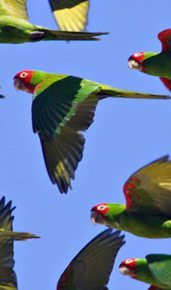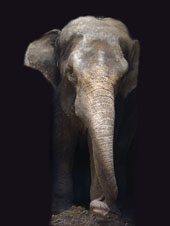 If you get a chance to see a wonderful film called “The Wild Parrots of Telegraph Hill,” which recently came out on DVD and video, or to read the book (by Mark Bittner), it’s well worth taking the time to do so. It’s the story of a flock of wild parrots who have lived free in San Francisco for 20 years and a man, Bittner, who became their friend and protector. Bittner was homeless for 15 years, and his story of finding meaning and purpose in his life through his association with the flock is as moving as the stories of the individual members of the flock.
If you get a chance to see a wonderful film called “The Wild Parrots of Telegraph Hill,” which recently came out on DVD and video, or to read the book (by Mark Bittner), it’s well worth taking the time to do so. It’s the story of a flock of wild parrots who have lived free in San Francisco for 20 years and a man, Bittner, who became their friend and protector. Bittner was homeless for 15 years, and his story of finding meaning and purpose in his life through his association with the flock is as moving as the stories of the individual members of the flock.
What I particularly loved about the film was that it demonstrated some of things that I see over and over again in working with people and their animals and in healing wild and exotic animals.
1) Animal easily recognize kindness and compassion and are quickly drawn to it. Bittner’s small acts of kindness and sincere interest in the parrots drew them to him and initiated a deep and life-changing relationship.
2) Animals give as much as they receive. They give extraordinary gifts in return for the love and compassion shown them and can transform human consciousness. Bittner had studied philosophy and Buddhist teachings for many years; however, his interactions with the flock gave him a new understanding of the meaning of much of what he had read.
3) Respect for animals’ wisdom, autonomy, and freedom of choice is vital in establishing an authentic and intimate relationship with them. Bittner honored the individual members of the flock as valuable beings and tried to understand their life from their perspective. In doing so, he gained their trust and learned enormous lessons about the deeper meanings of life and death. In teaching healing, I always stress that this kind of respect is vital in establishing a relationship for healing.
4) Personal transformation and growth are often possible for both people and animals around the time of an animal’s transition, and animals often give their people wonderful gifts of insight through their transitions. Through the transition of Tupelo, one of Bittner’s closest friends in the flock, he came to understand that “wordless transmission of meaning” (what I would call animal communication or intuitive listening) occurs between beings and between species. For instance, speaking of watching the flock in flight, he says, “Scientists look for an outer signaling system, but I think the birds have such a ‘flock sense’ that at times they are of one mind. I picked up some of that flock sense, and at times it was uncanny. I almost always knew when there was a major development in the flock.”
5) The richness and complexity of animals’ emotional lives, relationships, and intelligence is much more like ours than most people understand. Our preconceptions often stand in the way of understanding this. Bittner learned much about the depth and complexity of the parrots’ emotions and relationships through his close interaction with them and ultimately understood that “All living creatures are personages, and the issues among us are similar.” He says:
“In Zen Mind, Beginner’s Mind, Sukoshi-roshi tells a story about a trip he took to Yosemite. While there, he stopped to watch a waterfall. It was one of the very tall ones, and he noted that when the stream at the top of the ridge hit the cliff, it split into many individual droplets on its way to the bottom. There the individual droplets came back together into one stream. I’d read that story many times without comprehending his point. At a basic level, it’s quite simple: There is one river until it hits that cliff, which is life. The one river then breaks up into many individual living beings-humans, animals, and plants-until we hit the bottom of the cliff and become one river again. Each droplet loses only its identity as a single drop. But nothing is really lost. It’s all still there. I’d encountered this in different ways many times over the years, but I’d never grasped it. It’s an elementary idea, and not so difficult to understand. But my problem was that I’d been thinking about consciousness solely in human terms. It wasn’t until I considered the minds of parrots that my outlook broadened. So my problem was not with anthropomorphism; rather it was with anthropocentrism, which is seeing human beings at the center of the universe. The parrots broke through that delusion. The understanding that ultimately came to me from looking in the parrots’ eyes was that their consciousness is one with mine. We are all one consciousness, and each finite being embodies a little piece of it. This is the preciousness of all that lives.”
The book contains much information that was not included in the film, and I highly recommend it, but the visual images in film are so great-very intimate and personal- that I recommend trying to see the film as well, if at all possible.




